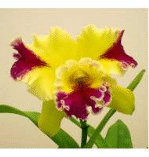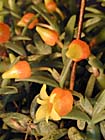Fasinating Orchid History: Come For A Short Tour. Orchids . . .

. . . date back to the Greek ages. Orchid history shows that at that time one of the orchids were associated with virility. Several books about orchid history have been written as orchids are this one of the most studied plants.
It is easy to learn all about orchids. Over the centuries orchids have been a symbol of love, luxury and beauty. Another one of orchid facts is seen in the Middles Ages where they were used as a remedy for a number of illnesses. They have also been considered an aphrodisiac and a main ingredient in certain love potions and even in ice cream!. Clearly, they have had a long and important relationship with humans for a very long time.
In the 18th century: Collecting orchids was well established and orchid gardening and care of orchids was becoming an interest. Although they were considered the flowers of the wealthy they were studied by only a few botanist including William Cattley. Cattley changed all of this. He first noticed the orchids which were later named after him, the Cattleya, were used as packing material in some plants that were sent to him. He discovered after re-potting the plant that it blossomed producing a beautiful and very fragrant flower.
In the late nineteenth century according to some orchid books orchids were being harvested in Europe without consideration for saving them. Whole areas, especially in England, were devastated by this harvesting. Fields lay barren as these orchids were picked and sold. There was not any conservation at this time.
Today most harvesting of wild orchids is generally banned. Today most of them that are for sale are reproduced by reputable orchid growers from plants in greenhouses.
Advances in science and methods for reproducting orchids have brought us to where we are today, with over 110,000 different hyrids. This is an amazing plant that has withstood the test of time and survived from the early Greek ages to modern times. There was essentially a transformation and conservation of the plants.

In the late nineteenth century according to some orchid books orchids were being harvested in Europe without consideration for saving them. Whole areas, especially in England, were devastated by this harvesting. Fields lay barren as these orchids were picked and sold. There was not any conservation at this time.
Today most harvesting of wild orchids is generally banned. Today most of them that are for sale are reproduced by reputable orchid growers from plants in greenhouses.
Advances in science and methods for reproducting orchids have brought us to where we are today, with over 110,000 different hyrids. This is an amazing plant that has withstood the test of time and survived from the early Greek ages to modern times. There was essentially a transformation and conservation of the plants.
Information from the American Orchid Society on Conservation
Conservation of the species and their habitats has been one of the chief aims of the American Orchid Society (AOS) since its inception nearly 80 years ago. Through the involvement of its knowledgeable members and dedicated staff, the AOS has played a major role in understanding orchid history, and have been formost in the formulation of world orchid conservation opinion and policies.
The AOS Conservation Committee serves as a communication nexus for conservation related news and information. Its members are often those who are called upon for expertise in matters relating to orchid conservation. The AOS's publications, and especially Orchids (formerly the AOS Bulletin), are in the forefront of communicating conservation related news. Also, this website, serves as a valuable "first page" for late-breaking and important conservation related issues, particularly on CITES issues as well as import and export related items.
These two venues are where the AOS primarily serves its main function: keeping its members and readers sufficiently informed in conservation related matters so that they may formulate their own opinions. Providing a forum for differing views also helps members to see the many sides of conservation issues.
AOS Staff and Conservation Committee members have also played an increasingly important role as liaison with United States federal agencies, such as USDA and USFWS, in communicating the opinions of the orchid community.
The AOS awards grants for non-commercial conservation projects, as well as experimental projects of fundamental and applied research on orchids. The purpose of these grants is to advance the conservation and preservation of them in every aspect. Conservation projects supported have been in areas as diverse as CITES publication funding, a conservation program for an orchid reserve, establishment of a secretariat for the IUCN/OSG, and other informational resources.
The American Orchid Society also has some good books for sale about Orchid History. Books and e-books are a good way to get orchid growing tips. Perfect way to help growing orchids for beginners.
Return to the top of orchid history page
Return to the Orchids Plus More Home Page
Home | Customer Service & Contact Information | Site Map | Security & Privacy


